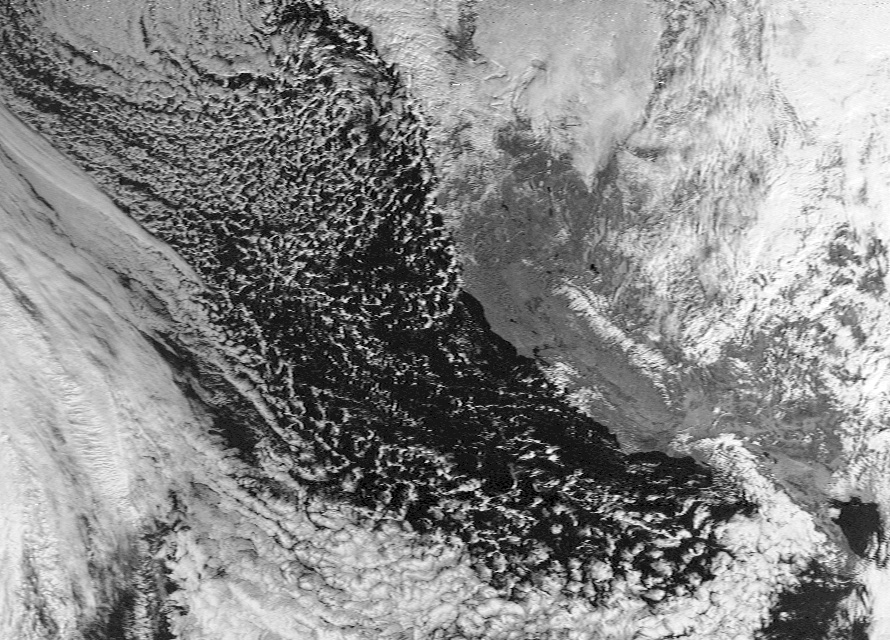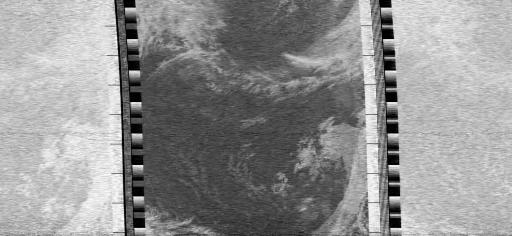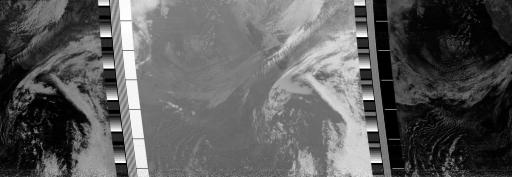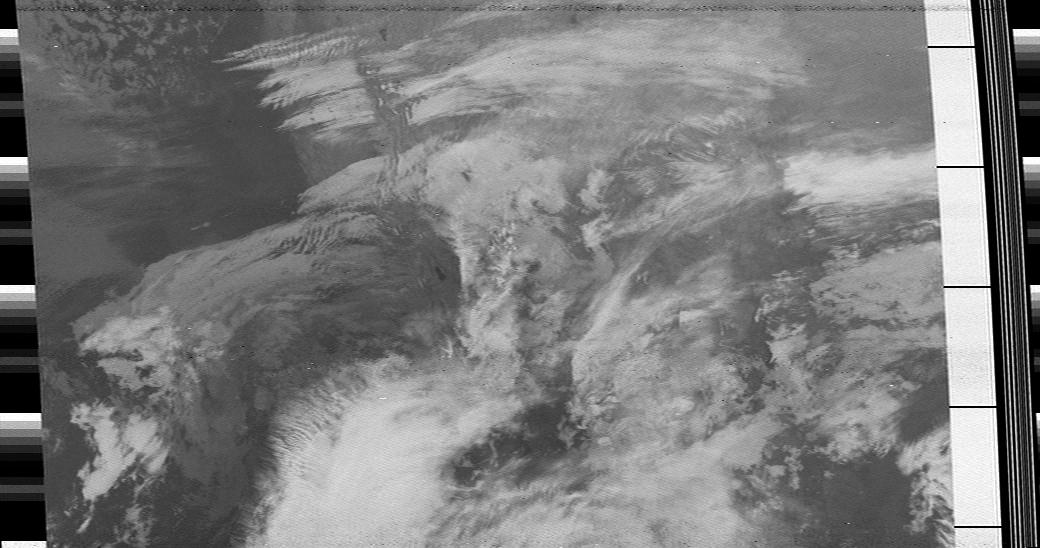The amateur satellite AO-7 was launched on November 15th, 1974. It was thought to be lost for years, until recently when chemistry changes in the batteries increased the resistance so that now when the satellite is in sunlight, its transponder is directly powered by its solar panels. While reading a post to the AMSAT-BB today, I found the following website which I hadn’t seen before. It has information on operating the satellite, and logs traffic to the satellite. Very cool.
Category Archives: Amateur Radio
Daytime Satellite Pass, with some image processing…
Well, I was awake for a decent daytime pass of NOAA17, so I wandered out into my front yard, and recorded the pass. It was a westward pass, covering from Canada all the way down to Baja California in the south, and was reasonably noise free over a great amount of it. I hauled it into gimp and did a bit of judicious image editing, and this is what I came up with:

I consider this to be pretty darned good for as ad-hoc as my approach to satellite reception actually is.
Another night time satellite pass…
I haven’t had the time to record some of the NOAA17 passes during the day, but once night falls, I’ve managed to record a few passes. Tonight, I decided not to use my Yaesu VX-3R, but instead tried to record the pass from my old Radio Shack PRO60 scanner. While I recorded a bit less of the pass than last night, the overall quality seemed really pretty good.
Night NOAA17 pass…
Best Satellite DX so far…
I was monitoring a routine pass of AO-51 this morning, just listening to some rag chewing, not really diving in myself, until we heard XF4YW calling. One of the regulars identified him as a rare DX, so we all tried to work him from DK48. I had no idea where DK48 was, or that XF4YW would be rare, but it turns out that Eduardo was operating AO-51 as part of a DX expedition to the Mexican island of Socorro. I don’t think he got my call correctly, but still, it was pretty neat. The expedition runs until the 15th of December, so I’ll be listening for him to make sure I work him again.
Here’s the mp3 of the pass. He shows up in the second half of the pass.
Addendum: You can read up about Socorro Island on Wikipedia. It’s area is only 132 square kilometers.
More weather satellite passes…
Well, I’ve been experimenting a bit more with some weather satellite reception, and on the off chance that anyone cares, I thought I’d write down some of what I learned. Last night (after dark) I decided to record an NOAA-17 pass. This time, I used my Yaesu VX-3R, which has a wideband FM setting, and my totally inappropriate Arrow Yagi that I have been using for satellite reception. I recorded the pass using a little Sony voice recorder. This was my result:

Bigger version, recorded with the Sony Voice Recorder…
It was during the dark, so I didn’t really expect to see much detail, but I noticed lots and lots of horizontal streaking. A moment’s thought made me realize that it was probably because the voice recorder compresses the audio, resulting in these short term artifacts. So, this morning, I lugged my laptop out into the yard and recorded some pristine, uncompressed audio. Here’s the result:

Full Size Version, recorded on my laptop…
What have I learned? That with a gain antenna that tracks, and the wideband fm setting, you can probably record some pretty reasonable images. Yes, it’s suboptimal: you get more noise in the image than the approrpriate bandwidth would allow. But still, they aren’t too bad.
I’m gonna work on improving my decoder some (45 lines of code really isn’t enough), and then maybe work on this some more when I’m on my christmas break.
Addendum: Sadly, when I tried to record a pass of NOAA18 over the ocean, I found another difficulty: intermodulation interference. I could hear a strong local FM station, and what sounded like aircraft audio superimposed with the satellite downlink. The results were far from stellar.
Ugly NOAA18 Pass, lots of interference…
Addendum2: A pass of NOAA-15 was happening just as sunset, and was going to be east of my position. Unfortunately, just as it was getting interesting, it shifted to a different mode or something, and I lost the super-cool looking grazing earth. But I did find that there are some places where perhaps I’m not as directly blasted by all the many sources of interference that I heard in the previous pass, so the overall pass is somewhat less noisy.

First attempt at receiving and decoding weather satellites…
Okay, this isn’t that impressive, but let me explain.

I recorded about 4.5 minutes of audio from one of the weather satellites, using my small pocket recorder and a Kenwood TH-D7A. In most respects, I shouldn’t expect anything good to happen. I’m using a cheap little voice recorder. I’m using a receiver that has insufficient receive bandwidth (this is probably the worst problem) and I’m using an antenna that’s tuned for a completely different band (still, the signal strength seems excellent). Still, all that aside, you can see the clear outline of Baja.
Well, I thought it was kind of neat. Makes me wish I had the right receiver though.
Addendum: I tried to record a few minutes of the satellite using the yagi and my old Radio Shack PRO-60 scanner set to wideband mode. Unfortunately, I didn’t have the right splitter setup, so I can’t track the antenna by hand as well, and it looks like I had some significant interference in the middle. I only caught the tail of the pass, so I didn’t really get much, but it might indeed be better, even though the bandwidth is way too large.
$25 TNC
Terminal node controllers are the “classic” approach to doing packet radio. They are basically dedicated modems that are used to implement a set of features that allow you to send and receive AX.25 formatted frames over amateur radio. The thing is: they are getting harder to find. My TH-D7a has a fairly sophisticated one built in, but if you have an ordinary HT, you’ll find yourself spending up to $100 or more for a packet modem.
Or, you could build one from a PIC microcontroller development board for $25 or so. My friend Richard is interested in doing this, I might have to give it a whack myself. While devices like the TinyTracker and such can be used to send packet radio, this one can also receive packet, and can act as a digipeater or dedicated APRS node. Neat!
A PRACTICAL ROTATOR SYSTEM (APRS)®
I mostly just wander out and wave my antenna around when I work satellites. Someday, I might want an automated system, and this can be built for less than a hundred bucks with stuff you can get from Radio Shack. Worth archiving.
First real qso via GO-32…
I was experimenting with APRS messaging via GO-32 this morning, after being simply overrun by Mexican hams earlier in the morning on AO-51. W7KKE runs a GO-32 SatGate in Lincoln City, Oregon (a place I’ve visited many times) and was apparently listening when I messaged him this morning via my TH-D7. I wasn’t using a computer, so it was rather like text messaging from a cheap phone, but here are the messages as recorded in my HT.
ID ID TH-D7G AMSG 01 AMSG 3,W7KKE-1,73s,I AMSG 02 AMSG *,W7KKE-1,handheld here,H AMSG 03 AMSG M,W7KKE-1,Good to see some GO-32 activity!,51 AMSG 04 AMSG 1,W7KKE-1,first qso on go32,G AMSG 05 AMSG M,W7KKE-1,Good morning!,50 AMSG 06 AMSG *,W7KKE-1,hi ken,F AMSG 07 AMSG 0,VA3SU-1,test,E AMSG 08 AMSG B,4XTECH-12,D7&D700 posits use 145.9s,3 AMSG 09 AMSG B,4XTECH-12,APRS msgs and clients use 145.85 Upl,2 AMSG 10 AMSG B,4XTECH-12,su APRS!!Use pth via 4XTECH,1 AMSG 11 AMSG 0,VA3SU-1,hi there ,D
Addendum: Using the information from here, it appears that the first number after the AMSG statement is either an M (indicating that the message is Mine), a B (bulletin), an asterisk (meaning the transmission was acknowledged) or a number (indicating the number of times that it will retry to send it). You can see that my attempt to reach VA3SU was unsuccessful, but that W7KKE acked a couple of my packets.
Digipeated APRS Fix via the ISS
I looked at oscar.dcarr.org, and noted that the ISS packet radio feed appeared to be back up. We had a 15 degree pass to the west (the most favorable direction, toward the east I have a S5 noise source), so I went out and waved my antenna around, and got the following packets digipeated:
KF6KYI-1>37UXPW,RS0ISS-4*,qAo,WA6LIE-4:'2+9l -/>kf6kyi@gmail.com KF6KYI-1>37UXPW,RS0ISS-4*,qAo,WA6LIE-4:'2+9l -/>kf6kyi@gmail.com KF6KYI-1>37UXPW,RS0ISS-4*,qAo,WA6LIE-4:'2+9l -/>kf6kyi@gmail.com
Nifty! I might leave it beaconing more today to see how I can do it just using my omni on the car.
To PCSAT-1 on 5w into an omni…
Now that I have a DC power converter in my car, I am able to run some experiments. Last night I left my radio in my car and hooked up to my mag mount roof antenna, tuned to 145.825Mhz, the frequency which has been designated for use by the APRS system via satellites. NO-44, NO-61 and the ISS (at least on occasion) are supposed to be able to digipeat APRS positioning packets on this frequency. This morning, I had three different stations recorded in my APRS log. I then decided to turn on broadcasting (once every 2 minutes). Sure enough, just an hour ago I managed to get a packet injected into PCSAT-1, showing my position @ Pixar Animation Studios.

This isn’t too bad, considering I’m sending only 5w into an omnidirectional antenna, and only once every two minutes, with unreliable transmission. Very neat.
The 500 KC Amateur Radio Experimental Group
I’ve been interested in low frequency radio (so-called “lowfer” operation) for quite some time. Because of the incredibly long wavelengths, lowfer operation relies on efficient transmission techniques to overcome the problem of seriously short and inefficient antennas. Still, lots of interesting stuff going on under Part 15 regulations, and recently some experimental stations have been provided a special operating license to conduct experiments around 500kc. Check it out.
Two more contacts via AO-51…
I caught the westward pass of AO-51 tonight that began at 9:18pm local, and caught K7WIN (DM41) calling by his lonesome on the satellite. After a bit of juggling with my antenna, I called out to him and got a QSO for the logbook. I heard another call, but lost it in some kind of deep fade, but managed to catch WB6YTE (DM12) just as I was in the tail end of the Doppler. That’s four QSOs via the bird to date. It was nice that the satellite wasn’t particularly crowded, it makes it easier to get and remember the calls.
[tags]Amateur Radio, AO-51[/tags]
New serial cable works, scripting for the TH-D7A
One of the reasons that I chose the Kenwood TH-D7A(G) as my hand held transceiver is its integration with packet radio. It includes a TNC (that’s terminal node controller) that works at either 1200 baud or 9600 baud. This allows it to exchange digital information over amateur radio frequencies. It also has the ability to connect to a GPS and send information over the APRS (Automatic Position Reporting System). This is an amateur system that allows individuals to broadcast positions over the amateur network, and is also used to broadcast weather information and for simple messaging.
It is actually quite capable even by itself, but obviously a great deal of additional capability can be had by linking the little HT to a computer. It’s actually setup for that pretty well, it only requires a couple of cables. Kenwood charges $50 or so for the cable + some software, which seems like a pretty harsh price, considering the cable has no active components, and the software.. well, as you see, you really don’t need.
So, instead I ordered some pigtails from Vetco Electronics. The cables are good quality, heavy and shielded and are exactly what you need, and cost $2.50. A trip to Fry’s (yes, I swore I wouldn’t go back to Fry’s, but I was in a hurry) netted a bag of female DB9 connectors (10 for $3.50) and a couple of shells to cover it (cheap $.59 a piece), and I was ready to go. The manual tells you what connections need to be soldered up (there are only three of them: ground, TX and RX) and voila. I hooked it to my old FreeBSD box, fired up minicom -o, and typed ID, to which the receiver echoed ID TH-D7AG. Cool, I was in!
I then had a bit of a miscue: the laptop I use is a MacBook, and of course, like many modern computers, it doesn’t have any DB9 ports. No problem thought I: I got on Amazon and ordered a Sabrent USB->serial converter for under $10. It advertises as being compatible with both OS X and with Linux, so I thought great! Sadly, it didn’t work at all, on either Linux or Mac OS X. I did a quick poll of our local Mac experts, and they recommended a KeySpan one. A trip to our local CompUSA netted one, at $40 (frown), but I must admit: it works just fine with their MacOS driver. There are some issues using it on Ubuntu under linux (driver licensing makes it not work by default) but for now, I am happy with just using it on my MacBook.
So…
Python is my preferred scripting language, so I wanted to use some of the programming information I had found earlier to control and access the information inside the TH-D7A. I downloaded the “pyserial” module for the MacBook, and wrote the following near trivial script:
#!/sw/bin/python2.5
import sys
import serial
s = serial.Serial("/dev/tty.KeySerial1", 9600, timeout=1)
s.write("r")
print s.readline()
s.write("IDr")
print s.readline()
for x in range(40):
s.write("LIST %02dr" % (x+1))
print s.readline()
s.close()
This program basically just makes the radio id itself, then gets the information for the 40 most recently scene stations received via APRS. Each station is identified by a callsign, and is followed by a latitude and longitude code,, and other information. The output looks like this:
ID TH-D7G
LIST 01,KI6GPQ-9,38335800122488501,/j,01,:, ,,220000------
LIST 02,KA6MAL-9,37079900122081701,/>,01,:, ,,329030------
LIST 03,KB7NV,39181300119316901,/-,,3, ,Tony, Dayton, Nv. kb,------------
LIST 04,KF6HJO,36306800119409101,/_,,6, ,p001P001b10201h00,137000056000
LIST 05,WA6AOB-12,39135 00121035 01,/k,00,:, ,,343000------
LIST 06,N6QGV-5,38168 00122031 01,/j,00,:, ,Kevin's Truck Sonoma,231000------
LIST 07,KE6FRA-14,37007400122020701,LK,,?, ,.3,031107,,*02,181017------
LIST 08,W6HMC,36361000121419601,/-,,4, ,Thanks for Supportin,3130--------
LIST 09,WB6AHC-1,37131000121511001,/_,,6, ,p000P000h65b10204tU2,259000060000
LIST 10,KA6DWN-9,37404700121536301,/>,02,:, ,,129035------
LIST 11,N6TBQ,------0--------0-, ,,6, ,p001P001h81b10173wU2,358000055000
LIST 12,N6ZOZ,36592000122018101,/j,02,:, ,CQ 144.390 100Hz Ton,283014------
LIST 13,W6CO-5,38220000122250001,/#,,4,N,W6CO Systems - SARS ,2736--------
LIST 14,N6RZR-3,40361000122390001,/#,,4,S,Wn,NCAn/APRS Digi Sh,5810--------
LIST 15,WA6YLB-12,36178900119155201,/j,02,:, ,,000023------
LIST 16,K6TJS-1,36089200120101201,/v,,7, ,odd's work mobile {U,323070------
LIST 17,KI6ETL-9,37226100121565501,/j,02,9, ,,103008------
LIST 18,K6FAA-9,37534400121144701,/k,,7, ,,000000------
LIST 19,WA6USI,38359500121296601,/_,,6, ,OD1w,301000075073
LIST 20,KE6GLA-14,38409700121007501,/k,01,:, ,Using Voice Alert 10,141000------
LIST 21,KF6HJO-5,36323800119409701,/>,01,8, ,,180056------
LIST 22,KC6SUS,37577900121255501,/',01,9, ,,045021------
LIST 23,KG6QPT,------0--------0-, ,,6, ,p000P000h..b.....tU2,332000053000
LIST 24,N5CV-2,37375400121527901,/>,,7, ,A=000324,358056------
LIST 25,K6MMG-1,37580500122222801,/s,,7, ,11.6V 29CTunapalooza,221000------
LIST 26,K6MZ,37262500122096301,/k,00,8, ,TinyTrak3,137000------
LIST 27,AA6AV,38197500122191401,/x,,4, ,ASTIR-Linux,3030--------
LIST 28,K6DKH-1,37415200122083901,/>,01,:, ,Lstng-146.640 PL-162,308050------
LIST 29,W6CX-3,37489400122037301,/#,,4,S,W2,NCAn/Rocky Ridge/,7450--------
LIST 30,KD6NIG-8,38424400121184901,/v,00,8, ,,331011------
LIST 31,AF6JP-5,37490100121172401,/>,04,:, ,,258000------
LIST 32,N6OIM-12,38398500121149701,/j,02,8, ,,269032------
LIST 33,SHASTA,41132900122142701,/#,,4,S,W3, K6SIS-3 NEAR DUN,5800--------
LIST 34,KF6TYS-7,38274500122434101,/-,02,:, ,Mark's D700 & GPS3+,000000------
LIST 35,KE6STH,37249100121514601,/j,02,:, ,1287.20- 88.5 /145.2,058035------
LIST 36,DANAHR,38446500120400801,/?,05,:, ,AG6AU: CALFIRE Publi,000000------
LIST 37,KE6YJC-7,36311000119473901,K,02,:, ,=,090035------
LIST 38,KG6QVB-2,37453100121206101,/k,02,:, ,145.550 simplex KG6Q,002064------
LIST 39,KG6PPD-8,37213300122048801,/_,,6, ,OU2k,340000063000
LIST 40,K4RJS-5,37245200121507701,k,01,8, ,,000000------
It’s a pretty small step from here to plotting their positions on a Google or Yahoo map. If I get some time, you can expect to see that soon.
Fun stuff.
[tags]Amateur Radio, APRS, Kenwood TH-D7A[/tags]
Addendum: A pass of the amateur satellite GO-32 just concluded, and I managed to pick up a couple of APRS packets from it. As recorded in my TH-D7A..
ID TH-D7G LIST 01,4XTECH-12,------0--------0-, ,,2, ,Sat Nov 03 17:57:55 ,------------ LIST 02,W7KKE,45006700124003501,/-,05,:, ,D-700 jpole Lincoln ,000000------
4XTECH-12 is the transponder aboard the satellite. W7KKE is a ham in Lincoln City, Oregon.
Modifying my program in a trivial way allowed me to dump the message buffers (the TH-D7A stores the last 16 messages it receives via APRS). This includes some more messages from the GO-32 satellite, and surprisingly a message from PCSAT-1. PCSAT-1 is also known as NO-44. It was passing to the west just as GO-32 was setting, so I hastily reconfigured the radio to talk to it, and I could hear it, but I didn’t think I decoded anything from it. Neat!
AMSG B,PCSAT-1,Look for dual hop paths and other experiments,4 AMSG B,4XTECH-12,D7&D700 posits use 145.9s,3 AMSG B,4XTECH-12,su APRS!!Use pth via 4XTECH,1 AMSG 0,K6MMG-1,g,1 AMSG B,4XTECH-12,D7&D700 posits use 145.93,3 AMSG B,4XTECH-12,APRS msgs and clients use 145.85 Upl,2 AMSG B,4XTECH-12,cu APRS!!Use pth via 4XTECH,1

